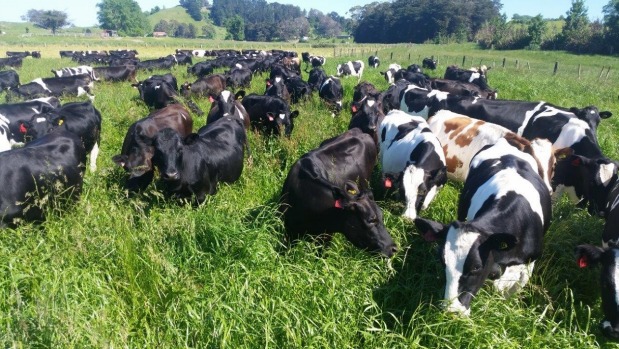The grazing regime on Mangarara Station is based on a holistic system originating from Zimbabwe with cattle grazed on a long rotation.
Owner Greg Hart said their animals have eaten, trampled and left dung and urine before moving on.
“We mimic that by using electric fences instead of lions and controlling the grazing so they get shifted every day. We’re not afraid of letting our grass get really long and tall in the summer time…
Rachel and Greg Hart of Mangarara Station with Doug Ducker from Hawke’s Bay Farm Forester of the Year sponsor Pan Pac Forest Products at a field day in April.
We do have to get a whole lot more natural cycling going on. We’ve been doing this for about three years now and we’re pretty happy with how it’s going. It’s not perfect but I think we’re definitely heading in the right direction.”
Utes travelling on Mangarara Station in Central Hawke’s Bay during a farm forestry field day in April.
Discussions on regenerative agriculture, sustainability and the importance of trees were part of a field day hosted on the property to celebrate Greg and his wife Rachel winning the Pan Pac Hawke’s Bay Farm Forester of the Year.
Mangarara staff member Sam Lang talks to the field day visitors about his recent Nuffield studies that fit perfectly with the farm’s regenerative agriculture philosophy.
From a vantage point overlooking Horseshoe Lake and a large portion of the 610ha farm, Greg pointed to some of the 150 dairy heifers grazing on the property.
“They’re a bit finicky and do need looking after so we’re probably finding a balance between that tall, rank pasture and the quality that young stock need to grow.”
The farm grazes 90 wagyu cows for Brownrigg Agriculture as well as the dairy heifers. It has 23 dairy cows and replacements – milking is a daily occurrence with most of the milk fed to the farm’s 100 free range pigs (including eight sows and piglets) as well as being consumed by the people living on the farm.
He said the pigs were still finding their place on the farm as they were higher input than the sheep and cattle and can damage the pasture they graze.
“We’ve been trying to avoid cultivation but the reality is the pigs are actually doing quite a bit of cultivation for us at the moment, so we will probably integrate some sort of cropping programme to clean up behind the pigs. But that’s the kind of stuff we’re still learning. We’ve got a long way to go.”
Greg said he found it hard to differentiate between the total hectares on the farm and the effective area as they wanted everything to be effective.
“We have the pigs in a line of redwoods at the moment so that’s an area being utilised and we’re getting a return off it.”
Feeding pigs on acorns was an extra use for a block of oak trees alongside timber and biodiversity.
About 125 laying hens are part of the process. They are free range and moved around the property behind the cattle adding their own layer of fertiliser to the land.
The number of ewes on Mangarara had dropped from 3000 to 800 but would probably settle at about 1000. About 700 of last year’s lambs were still on the property. The reason? Greg and Rachel direct market the farm’s meat through 10kg meat boxes, branded as The Family Farm, that include a mixture of lamb, beef, pork, bacon and sausages.
“It’s enough to do a family of four for about 10 meals. We’re shipping those around the country so we’re in the process of building our beef herd up again to cater for those meat boxes.”
That branding also highlights the Harts’ open gate policy for visitors. As well as being part of their agreement with the Air NZ Environmental Trust, the couple love welcoming people onto their land to get a taste of where their food comes from.
A large part of that is the Eco Lodge accommodation – two old school classrooms relined with macrocarpa that was grown and milled on the farm.
“It was a big job but great to have it so we can share the farm and share the journey we’re on with others.”
The Harts made special mention at the field day of Troy Duncan from the QEII National Trust and Hawke’s Bay Regional Council land management advisor Warwick Hesketh.
“Warwick has always worked tirelessly behind the scenes and what he does for us is invaluable. He has been with us for years,” Rachel said.
Other people mentioned were the endless number of wooffers who had passed through the property – overseas workers who help out and learn organic growing in exchange for board – as well as the young staff on the farm – Sam Lang, James Mills-Kelley and Anna Bailey and the Hart’s children – George, Bill and Emma.
“They are the reason we do what we do. We want to make change for the future… for their future.”
An open planting day is planned for June 7.
“This is just the beginning for us. We feel like we’ve just started to integrate trees into our production systems and the goal is to incorporate fruit and nut trees into the pastoral farming system to create perennial fields of food.
“We’re growing a community of people who help us steward the land by either joining the farm’s meat club or becoming a Friend of the Farm. We’re going to get together for a brainstorming session to see what might be possible on a place like this when we work together to optimise life.”
– Stuff